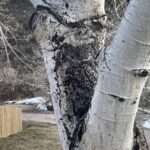Hypoxylon Canker
Hypoxylon canker is a fungal disease that affects a variety of tree species, including oak, maple, birch, hickory, and others. The disease is caused by fungi in the genus Hypoxylon, which invade and kill the inner bark and cambium of the tree, eventually causing branch dieback and tree mortality.
The disease often begins with an injury or stress to the tree, such as drought, frost damage, or pruning wounds, which provides an entry point for the fungal spores. Once inside the tree, the fungus grows and spreads, causing cankers to form on the bark. These cankers are typically black or dark brown, and may have a rough or cracked appearance. Over time, the cankers may enlarge and girdle the branch or trunk, leading to dieback and eventual death of the tree.
Hypoxylon canker is most common in trees that are stressed or weakened by other factors, such as poor growing conditions, insect infestations, or other diseases. Trees that are already damaged or in decline are especially vulnerable to the disease. Control measures for hypoxylon canker are generally aimed at reducing tree stress and preventing injuries or wounds to the bark. This may include proper irrigation, fertilization, and pruning practices, as well as avoiding damage to the tree from construction or other activities.
There is no cure for hypoxylon canker once a tree is infected. However, prompt removal of infected branches or trees can help limit the spread of the disease. In some cases, systemic fungicides may be effective in slowing the progress of the disease, although this is not always a practical or cost-effective solution.
Overall, prevention is the best approach to managing hypoxylon canker. By keeping trees healthy and avoiding injuries or stress, homeowners and landscapers can help prevent this and other fungal diseases from affecting their trees. Regular inspection and monitoring of trees for signs of disease or insect infestation is also an important part of maintaining healthy trees.



